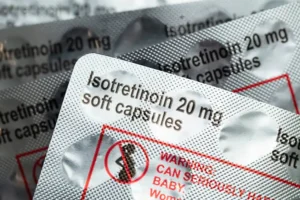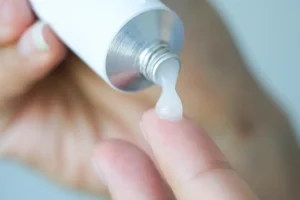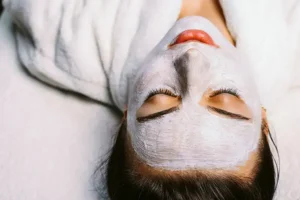You’re doing everything right. Cleansing, moisturizing, applying your serums and SPF—maybe even double-cleansing and masking regularly. But somehow, the breakouts won’t quit. Sound familiar?
You might be dealing with something sneaky: product acne, caused by comedogenic ingredients hiding in your skincare or makeup.
Yep, some of the most “clean,” “natural,” or even “dermatologist-approved” products could actually be clogging your pores. And if you’re acne-prone, even one use of the wrong product can kickstart a frustrating cycle of breakouts.
Let’s break down what “comedogenic” actually means, how to spot product-triggered acne, and how to build a routine that actually supports clear, healthy skin.
What Is Product Acne (a.k.a. Acne Cosmetica)?
Product acne—also known as acne cosmetica—is a type of breakout caused by pore-clogging ingredients in skincare, makeup, haircare, or even sunscreen. It’s one of the most overlooked causes of acne, and yet, nearly everyone with persistent breakouts is using at least one comedogenic product without realizing it.
How to Spot Product Acne:
- Tiny, flesh-colored white bumps or clogged pores
- Often appears in clusters
- Typically non-inflamed (no redness or pain)
- Common areas: forehead, cheeks, jawline, hairline, neck, chest, and back
Unlike hormonal or cystic acne, product acne doesn’t usually hurt—it just messes with your skin texture and won’t budge no matter how much salicylic acid you throw at it. That’s because the root cause isn’t bacteria or oil—it’s your products.
What Does “Comedogenic” Actually Mean?
“Comedogenic” is just a fancy word for pore-clogging. Ingredients labeled as comedogenic have been scientifically shown to block pores and lead to acne—especially in those with acne-prone skin.
Here’s the thing: not all oils, butters, or thick creams are bad. But some ingredients are known repeat offenders, and they’ve been studied for how likely they are to cause breakouts. Scientists even created a comedogenicity scale from 0 to 5:
| Rating | What It Means |
| 0 | Non-comedogenic |
| 1–2 | Low likelihood to clog |
| 3 | Moderately comedogenic |
| 4–5 | Highly comedogenic |
If you have acne-prone or sensitive skin, anything with a rating of 3 or above should be approached with caution—or better yet, avoided altogether.
How to Spot Comedogenic Products (Before They Ruin Your Skin)
Reading ingredient labels might sound overwhelming, but once you know what to look for, it gets easier—promise.
Here’s how to scan your skincare like a pro:
Ignore the Marketing Claims
“Non-comedogenic.” “Oil-free.” “Dermatologist tested.”
These phrases sound reassuring, but here’s the catch: they’re not regulated.
Brands can slap them on a label even if the product contains highly comedogenic ingredients (yep, wild).
So instead of trusting the front of the bottle, flip it over and…
Check the Full Ingredient List
Look for red flags like:
Fatty Acids & Esters
- Isopropyl Myristate (5) – Found in primers, makeup removers, and even acne products.
- Isopropyl Palmitate (4) – Common in moisturizers, BB creams, and sunscreens.
- Myristyl Myristate (5) – Thickening agent in creams, often in “rich” or “luxury” moisturizers.
- Ethylhexyl Palmitate (4) – Found in sunscreen, primers, and tinted moisturizers.
Comedogenic Oils & Butters
- Coconut Oil (4) – One of the most comedogenic natural oils. Common in moisturizers, masks, and “clean” beauty products.
- Almond Oil (2–3) – Found in many natural and organic formulas. Nourishing, but risky for acne-prone skin.
- Avocado Oil (2–4) – Rich in fatty acids and antioxidants, but has a high clogging potential for sensitive skin.
- Olive Oil (2–4) – Anti-inflammatory, yes—but also comedogenic. Often found in hydrating and anti-aging products.
- Argan Oil (0–1) – Technically low on the scale, but untested in key studies. Still best to avoid if you’re breaking out.
- Rosehip Oil (1–3) – Known for brightening and fading scars, but can be pore-clogging depending on your skin.
- Tamanu Oil (2) – Great for wound healing, but not acne-safe due to its thicker consistency and higher rating.
- Pumpkin Seed Oil (2–3) – Full of zinc and fatty acids, but comedogenic risk is moderate and research is limited.
- Hemp Oil (0) – Said to be non-comedogenic, but not studied in major acne-safe tests. Avoid if unsure.
- Borage Oil (Unknown) – Often used for its soothing properties, but has not been tested for acne safety.
- Walnut Oil (1–2) – Nutrient-rich, but under-tested. Not worth the gamble if your skin is reactive.
- Wheat Germ Oil (5) – Extremely comedogenic. One of the top ingredients to avoid for breakout-prone skin.
- Cocoa Butter (4) – Thick, creamy, and known to clog pores—especially on the face, back, and chest.
- Mango Butter (Unknown) – Loved in body care but under-tested for facial use. Use with caution if acne-prone.
These may sound nourishing or natural—and they are—but if you’re acne-prone, they’re not worth the risk.
Waxes & Emulsifiers
- Lanolin (4) and Lanolin Derivatives – Found in lip balms, creams, and diaper rash ointments.
- Laureth-4 (5) and Oleth-3 (5) – Emulsifiers in face washes and lotions.
- Cetearyl Alcohol + Ceteareth-20 – A sneaky combo that’s more comedogenic together.
Colorants & Pigments
- D&C Red #30 and #36 (3) – Common in blush, lipstick, and tinted moisturizers.
- Algae Extract (5) – Found in “anti-aging” serums and spa-inspired formulas.
Even if these are low on the list, they can still clog pores—especially in leave-on products like moisturizers, foundations, or sunscreens.
Building a Non-Comedogenic Routine (That Actually Works)
If you suspect product acne, the first step is a skincare detox. That doesn’t mean skipping skincare—it means simplifying and removing anything that could be triggering your breakouts.
Step-by-Step: Detoxing Your Routine
Strip It Back to Basics
Start with a minimalist routine:
- Gentle, non-stripping cleanser
- Light, non-comedogenic moisturizer
- Broad-spectrum SPF (also non-comedogenic)
Eliminate Known Offenders
Stop using any product that contains comedogenic ingredients. Don’t forget to check your haircare, makeup, and sunscreens too—they’re often the biggest culprits.
Reintroduce Slowly
Once your skin starts to clear (usually 2–4 weeks), you can slowly reintroduce products one at a time. If a product causes new bumps? You’ve found a trigger.
What Oils Are Actually Safe to Use?
Not all oils are bad—but many are. Unfortunately, some of the most hyped “clean beauty” oils are major pore-cloggers.
Here’s a quick cheat sheet:
Acne-Safe Oils (Non-Comedogenic)
- Jojoba oil
- Safflower oil (cold-pressed, high linoleic)
- Sunflower oil (cold-pressed)
- Squalane
- Castor oil
- All essential oils (as long as they’re diluted)
Myth-Busting: Let’s Clear This Up
MYTH: “If it’s organic or clean, it must be good for my skin.”
Not always. Organic avocado oil? Still a pore-clogger.
MYTH: “Only thick, greasy products cause product acne.”
Lightweight gels and serums can be just as problematic if they contain comedogenic ingredients.
MYTH: “My skin purges every time I try something new—it’s normal.”
Purging does happen, but ongoing breakouts or textured bumps are more likely signs of irritation or comedogenic buildup—not a “normal adjustment.”





